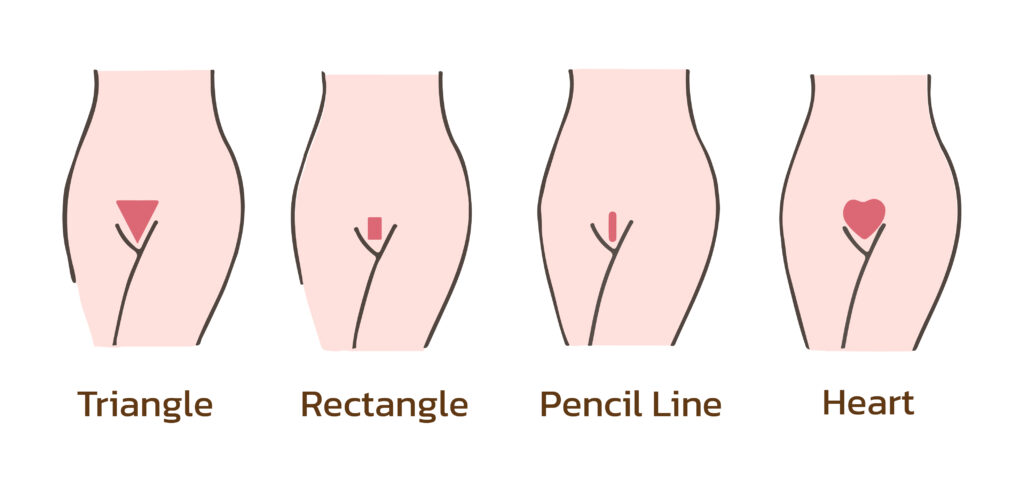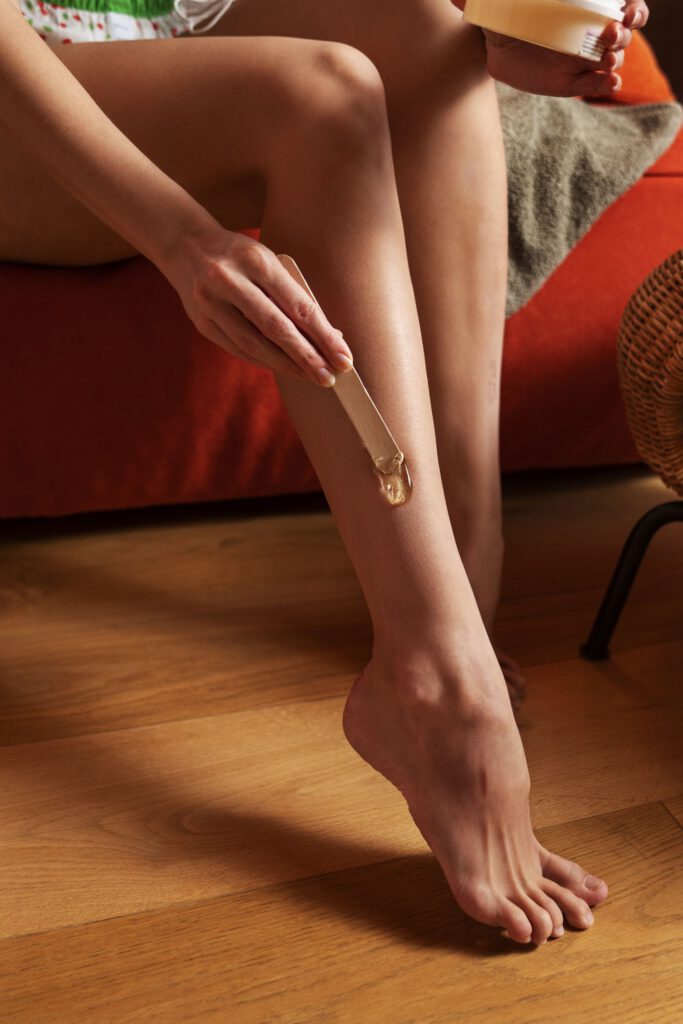Bikini wax refers to a method of using wax to remove hair from the intimate and surrounding areas. This method is popular among women for enhancing confidence and maintaining hygiene in the intimate area. For those trying bikini waxing for the first time, concerns about pain are common and normal, but the level of discomfort can vary. To better understand, let’s explore together with us a professional waxing salon in Bangkokand what bikini waxing involves.
What is Bikini Wax?
Bikini Wax involves using wax to remove hair from the genital area and its surrounding regions. Often considered a beauty trend, it enhances confidence for women wearing swimwear and helps maintain hygiene in the intimate area.
Get to Know the V.I.O Line
First, let’s familiarize ourselves with the V.I.O Line to better understand the differences between each type of wax!
- V Line refers to the hair in the front bikini area, extending beyond the bikini line.
- I Line is the hair in the most sensitive area, specifically the hair between the legs.
- Line is the hair in the buttocks area.

How Many Types of Bikini Wax Are There?

Bikini Wax, or the method of waxing the intimate area, comes in two types based on the waxing technique, Hot Wax and Strip Wax. Here are their differences:
- Hot Wax: This method is commonly used for hair removal on delicate areas of the body, such as the bikini area. Hot wax is more complex compared to strip wax because it requires the wax to be heated until it melts. This allows the wax to adhere more effectively to the skin, enabling the removal of hair from the root more thoroughly than cold wax.
- Strip Wax: This method uses wax made from natural ingredients like sugar, water, and honey. It is suitable for individuals who are new to waxing and have relatively sensitive skin. The wax can be applied directly to the area where hair removal is desired, allowed to dry, and then removed by pulling in the opposite direction of hair growth with speed and force. This technique may require some expertise, as improper application can lead to hair breaking rather than being removed from the root.

Types of Bikini Wax
When it comes to bikini waxing, there are three main types, each with its own details:
1. Bikini Line: Waxing the Panty Line
This involves waxing the hair that extends beyond the edges of your underwear, following the direction of hair growth (up and down). This type of waxing is ideal for those new to waxing, targeting only the area just outside the panty line, typically about the width of one spatula.
2. Traditional Brazilian Wax
This method is similar to the Bikini Line wax but extends further, waxing about the width of two spatulas inside the panty line. This method is very popular as it removes most of the hair, leaving only a small amount, which increases confidence when wearing a bikini.
3. Full Monty/Hollywood Wax
This Full Monty/Hollywood Wax involves removing all hair from every area—front, underneath, and back. It’s a complete hair removal technique, leaving no hair behind, resulting in smooth, clean skin. This method boosts confidence and allows for thorough cleanliness.
Bikini Playboy Design Waxing

Bikini Playboy Design Waxing is a popular choice among many women because it focuses on fashion and allows for various shapes to be styled. Let’s take a look at some of the design options available for bikini waxing:
- Triangle – Waxing in the shape of a triangle
- Rectangle – Waxing in the shape of a rectangle
- Pencil Line – Waxing in a thin straight line
- Heart – Waxing in the shape of a heart
Pain Levels in Bikini Waxing
When considering a bikini wax, it’s important to weigh the benefits of beauty, cleanliness, and good hygiene against the level of pain, which varies depending on the type of waxing. Of the three types, the Bikini Line is the least painful, removing only a small amount of hair around the bikini line. The Traditional Brazilian method, which removes more hair but leaves a small strip, results in moderate pain. The most intense option is the Full Monty/Hollywood wax, which removes all hair from the entire area, making it the most painful of the three.
How Long Does a Bikini Wax Last?
When you decide to get a bikini wax, one thing you should know is that waxing involves using wax to remove hair all at once, sparing you the pain of plucking each strand individually. However, it’s important to be aware that new hair will grow back. Typically, hair in the waxed area will start to regrow every 1-2 months.
Risks of Bikini Waxing
In addition to the benefits of getting a bikini wax, there are also precautions to be aware of when undergoing the procedure. These include:
Invisible Small Wounds
Bikini waxing, as is well known, involves removing hair from the root. This method pulls the hair out from the follicle, causing tiny tears in the tissue around the follicle opening, which can lead to inflammation. Additionally, the outer layer of skin may peel off with the wax, resulting in small, invisible wounds on the skin. Repeated waxing can potentially cause scarring over time.
Infection Risk
When small wounds occur around hair follicles and from the peeling of the outer skin layer during waxing, it can lead to inflammation in those areas. Additionally, these wounds can become infected due to the presence of bacteria. When bacteria enter the wounds, it can cause severe and persistent inflammation.

Ingrown Hair
Frequent bikini waxing can lead to inflammation of the hair follicles and skin. As the body repairs these areas, new skin cells grow, which can clog the hair follicles. This prevents new hair from growing out of the skin, causing the hair to grow back underneath the skin and eventually leading to ingrown hairs.
Read More: What Causes Keratosis Pilaris and How to Treat It for Smooth Skin
Can You Do Bikini Waxing at Home?
Yes, you can perform a bikini wax at home. You can purchase waxing kits from department stores or beauty product retailers. If you find it inconvenient or challenging to prepare waxing equipment, there are also pre-waxed strips available for quicker and easier use.
However, it’s important for first-time waxers to study the product and the waxing method carefully. Many people who wax for the first time might not know the correct technique or the appropriate amount of force to use, which can lead to severe pain, bleeding, and inflammation of sensitive skin. Additionally, first-time waxers should be aware of the chemicals in the waxing product, as some brands may contain fragrances or other ingredients that can cause allergic reactions. Therefore, it is crucial to research and understand the product before waxing.
Preparing for Waxing
Once you understand what bikini waxing involves and decide to proceed, let’s look at how you should prepare with the following steps:
- Check for ingrown hairs: If you have any, exfoliate the skin 48 hours before waxing.
- Avoid shaving or trimming hair for 4-6 weeks prior to waxing.
- Avoid waxing when your skin is particularly sensitive during menstruation. If unavoidable, use tampons.
- Avoid sexual activity before waxing, as the genital area may become swollen and red after intercourse, increasing the risk of pain and severe irritation.
- Avoid waxing for at least 6-12 months after surgery, as the wound may not be fully healed.
- Taking pain medication before waxing can help reduce inflammation and pain, as the skin in the area may become inflamed after the procedure.
Waxing Procedure
Although every wax studio may have its own specific procedures, most places follow these general steps:
- Prepare the Area to be Waxed: It is important to consider the length of the hair. The hair should be at least 0.64 cm long and no longer than 1.3 cm. If the hair is too short, the wax will not adhere properly. It’s advisable to let the hair grow for about 1-2 weeks. On the other hand, if the hair is too long, the wax may stick excessively and cause discomfort. Therefore, it’s necessary to trim any excess with a hair trimmer.
- Clean and Exfoliate the Skin: Use a mild soap to clean the skin and hair in the intimate area to reduce the risk of infection and remove excess oil. This helps the wax adhere better to the hair and skin.
- Apply the Wax: Use a spatula to scoop up the wax and spread it gently onto the area you wish to wax. The wax should be applied to a thickness similar to that of a coin. Spread the wax in the direction of hair growth to minimize discomfort, and extend it slightly beyond the edge of the hair area to allow space for handling later. You can start waxing any area, and then gradually continue to apply the wax in sections. Allow the wax to sit and harden.
- Remove the Wax: Once the wax has fully hardened, use one hand to stretch the skin near the edge of the wax strip. With the other hand, grip the edge of the wax to be removed. Take a deep breath and quickly pull the wax off in the opposite direction of hair growth. Afterward, gradually remove any remaining wax to continue with other areas.
- Remove Residual Hair, Cleanse, and Moisturize the Skin: After waxing, some stray hairs may remain. Use tweezers sanitized with alcohol to remove these remaining hairs. Then, rinse off any wax residue with clean water and dry the area. Apply aloe vera gel to the freshly waxed area to soothe irritation and reduce inflammation.
Post-Bikini Waxing Care
- Avoid Exercising Immediately After Bikini Waxing: After a bikini wax, the skin in that area is particularly sensitive. Exercising can cause friction and increased sweating, which may lead to irritation and exacerbated inflammation. It is advisable to avoid exercising for 2-3 days following the bikini wax.
- Avoid Wearing Tight Clothing: Wearing tight clothing after a bikini wax can cause the fabric to rub against the freshly waxed area, leading to friction and increased moisture, which can exacerbate inflammation. Therefore, it’s best to wear loose and comfortable.
- Avoid Hot Baths, Swimming Pools, and Sea Water Immediately: Taking hot baths, swimming, or going into the sea right after a bikini wax can trigger inflammation in the skin. Hot water, chlorine in swimming pools, and the high salt content in sea water can all irritate the freshly waxed area. To allow your skin to recover, it’s best to avoid these activities for 2-3 days.
- Exfoliate the Skin 2-3 Days After Waxing: Two to three days after a bikini wax, it’s important to exfoliate the skin. Exfoliation helps remove dead skin cells that may have become dark and discolored, promoting a brighter and more even skin tone in the intimate area. It also helps prevent and reduce the occurrence of ingrown hairs.
Other Alternatives to Bikini Waxing
In addition to bikini waxing, let’s explore other methods for removing hair from the intimate area, and examine their pros and cons.

1. Shaving
This method is popular among many people because it is easy, quick, and cost-effective. Additionally, the equipment used is simple and not cumbersome.
Pros: Quick, saves time, and budget-friendly.
Cons: Easily causes skin injuries, risks of cuts and infections, and new hair growth may be coarse, leading to discomfort and itching. This can result in a desire to scratch, potentially affecting your appearance.

2. Plucking
This method is considered classic, using only tweezers as the tool. It is also a budget-friendly option.
Pros: The equipment required is just tweezers.
Cons: This method can be painful and uncomfortable because it involves plucking hairs one by one, which is time-consuming. After plucking, red spots may appear due to the tearing and inflammation of hair follicles. Incorrect plucking direction can cause bleeding, leading to the formation of “chicken skin,” ingrown hairs, and potential abscesses.
3. Hair Removal Creams
Nowadays, there is another method that helps women avoid the pain of shaving and plucking, while also being cost-effective. This method involves dissolving hair using thioglycolate, a chemical found in over-the-counter hair removal creams.
Pros: Pain-free and quick hair removal process.
Cons: As it involves chemicals, users may experience skin irritation, pain, burning, and itching. It can also cause skin darkening. Additionally, it does not prevent hair regrowth, which typically occurs within 2 weeks.

4. Bikini Laser
Currently, laser hair removal is a popular method among women for treating bikini hair. This method is relatively painless due to the use of a Dynamic Cooling Device, which releases a cold gas simultaneously with the laser. The laser employs a wavelength of 1,064 nanometers to target and destroy hair follicles using the Long Pulse ND YAG technology, which is highly safe and does not harm the sensitive skin in the intimate area. Treatments can be conveniently performed at Gangnam Clinic, typically taking only 3-4 hours.
Pros: No more time spent on hair removal, cost-effective compared to other methods that require multiple treatments, reduces the risk of infections and ingrown hairs, results in smooth and even skin, and provides permanent hair removal.
Cons: Must be performed by a professional, and multiple sessions (5-8) may be required for permanent results.
Summary
We hope this article inspires many women to take better care of their intimate areas for both confidence and good hygiene. This will help you feel free to show off your bikini on a sunny holiday, enjoying the blue skies, the sea, the breeze, and the company of your special someone.
Contact Us at Wax & Co, the Spa-Style Waxing Salon, HERE
You can book an appointment for waxing or inquire for more information through the channels below. Alternatively, you can visit any of our branches, just go to the one nearest you. Don’t let unwanted hair affect your confidence.
- Facebook: Wax & Co ร้านแว็กซ์สไตล์สปา
- Website: www.waxand.co
- Telephone: 063-9545166






